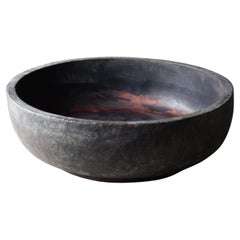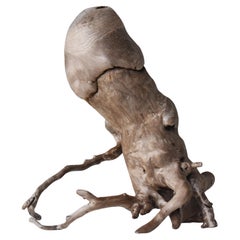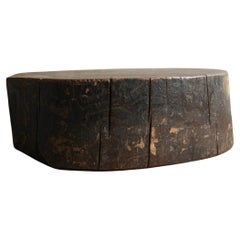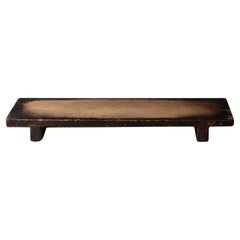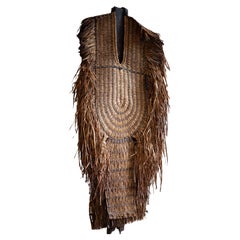Japanese Antiquities
to
86
130
41
387
14
2
3
2
1
29
110
248
16
135
23
57
4
2
4
2
2
3
5
5
15
3
184
106
72
51
50
1,876
1,335
732
403
372
403
400
400
10
1
1
1
1
Place of Origin: Japanese
Japanese Antique Huge Wooden Bowl 1906s / Primitive Object Wabisabi Mingei
Located in Chōsei District Nagara, JP
This is a huge old Japanese lacquer wood bowl.
It was manufactured in 1906 (Meiji period), and its age can be read from the writing on the bottom. The material used is cedar wood, ma...
Category
Early 1900s Meiji Antique Japanese Antiquities
Materials
Cedar, Lacquer
Japanese Antique Natural Wood Penis 1860s-1920s / Figurine Object Wabisabi
Located in Chōsei District Nagara, JP
This is a phallic statue made of natural wood produced in Japan.
It is estimated to have been created during the Meiji and Taisho periods (1860s-1920s), and is made of richly texture...
Category
Early 20th Century Meiji Japanese Antiquities
Materials
Pine
Japanese antique wooden work board / 20th century / small display stand
Located in Sammu-shi, Chiba
This is an old Japanese wooden workbench made from zelkova wood (keyaki), known for its hardness and beautiful grain. The thick cross-sectional shape clearly reveals the concentric g...
Category
20th Century Taisho Japanese Antiquities
Materials
Wood
Japanese Antique Wabi-Sabi Black Ladder 1800s-1860s / Primitive Object
Located in Chōsei District Nagara, JP
This is a very old black ladder made in Japan.
The simple construction and condition suggest that it was used in the late Edo period (1800s-1860s).
It is made of cedar wood with stra...
Category
Late 19th Century Primitive Antique Japanese Antiquities
Materials
Straw, Cedar
Japanese Antique Exhibition Table / Wall Decoration / 1868-1912s / Wabi-sabi
Located in Iwate-gun Shizukuishi-cho, Iwate Prefecture
This is an old Japanese wooden work board.
The wood is cedar, and due to long-term use, the black color around the edges remains, and the color has peeled off only in the middle. Th...
Category
Late 19th Century Meiji Antique Japanese Antiquities
Materials
Wood, Cedar
Antique Japanese Mino straw cape made of rice straws, mingei wabi sabi art piece
Located in 常陸大宮市, JP
Antique "Mino", also called "Bandori" Straw cape made of rice straws - From Tohoku area, Japan.
Dear customer - feel free to inquire me for the shipping fee quote.
The shipping fee ...
Category
Late 19th Century Taisho Antique Japanese Antiquities
Materials
Cotton, Linen, Straw
Japanese old wood stand / Exhibition stand wabi-sabi / primitive wood stand /
Located in Sammu-shi, Chiba
This display stand is made by combining old wooden sleepers with a newly made tabletop.
The top of the display stand is finished with cashew paint, like lacquer, and has a jet blac...
Category
Mid-20th Century Primitive Japanese Antiquities
Materials
Wood
Old Japanese black maneki-neko object / 20th century / lucky ornament
Located in Sammu-shi, Chiba
Here is a Japanese "Maneki Neko" (beckoning cat) figurine from the Showa era. It is made from either clay or plaster and features a simple yet impactful design. On the back, you can ...
Category
20th Century Showa Japanese Antiquities
Materials
Plaster, Clay
Japanese Red Samurai Armour Beginning of Meiji period 1900s
Located in Paris, FR
This is an armour of samurai. It was made around 1900s in Meiji era. This armour was not used in actual war so it was made as decoration, because of that, it is in good condition as its age.
There are some scratches and missing parts, if you need some more information, please let us know, we will respond you as soon as possible and send more photos.
This armour can be folded in a box. The box is getting damaged so it is not in good condition. We might send this armour in other box.
Dimensions: 50 x 50 x H170 cm
Scholars agree that Japanese armour first appeared in the 4th century, with the discovery of the cuirass and basic helmets in graves. During the Heian period, the unique Japanese samurai...
Category
Early 1900s Meiji Antique Japanese Antiquities
Materials
Metal, Iron
Antique Japanese Kimono 'Uchikake' for Wedding, 1970s
Located in Paris, FR
This is a kimono called Uchikake which Japanese women wear for wedding ceremony.
It is said that the women wear the white uchikake for the reason of 'they can dyed in any color' and...
Category
Late 20th Century Showa Japanese Antiquities
Materials
Silk
Japanese Antique Combat Helmet 'Kabuto' 1800s Edo Era
Located in Paris, FR
This is an antique combat helmet made around 1800s in Edo era in Japan.
Kabuto is a type of helmet first used by ancient Japanese warriors which, in later periods, became an important part of the traditional Japanese armour...
Category
Early 19th Century Antique Japanese Antiquities
Materials
Iron
$3,177 Sale Price
20% Off
Japanese Half Kimono Belt Hanhaba Obi Sky Blue with Rose 1980s
Located in Paris, FR
This is a Japanese beautiful Kimono belt called 'Han haba obi'.
Both side are with motifs but different motifs. It is a belt for kimono but you can use as a table runner or wall deco...
Category
1980s Showa Vintage Japanese Antiquities
Materials
Silk
Japanese Silk Haori Jacket Shibori Red 1980s Showa
Located in Paris, FR
This is a silk jacket which was made in Japan.
It was made in Showa era around 1980s.
The haori is a traditional Japanese hip- or thigh-length jacket worn over a kimono. Resembling ...
Category
1980s Showa Vintage Japanese Antiquities
Materials
Silk
Japanese antique wooden octagonal display stand/bonsai stand/flower stand
Located in Sammu-shi, Chiba
This is an old wooden flower stand from Japan.
It is believed to be from around the 20th century.
Originally, it may have been used in temples to hold offerings of flowers, but this ...
Category
20th Century Taisho Japanese Antiquities
Materials
Wood
Extremely Rare Tokugawa Clan Kimono Hanger with Maki-e Lacquer. Edo period
Located in Fukuoka, JP
Extremely Rare Tokugawa Clan Kimono Hanger with Makie Lacquer and Gilded Fittings
Edo Period, 18th–19th Century Dimensions: H 166 cm × L 187 cm × W 41.5 cm Materials: Wood, Lacquer...
Category
18th Century Edo Antique Japanese Antiquities
Materials
Metal
Japanese Antique Large Ceramic Shrine 1860s-1920s / Object Wabi Sabi
Located in Chōsei District Nagara, JP
This is an old Japanese pottery shrine (zushi).
It was made during the Meiji and Taisho periods (1860s-1920s), and was mainly placed in gardens to enshrine deities.
The word “zushi” ...
Category
Early 20th Century Meiji Japanese Antiquities
Materials
Ceramic
Japanese antique pottery fragments/12th to 13th century/Flower vase
Located in Sammu-shi, Chiba
Tokoname ware is a historic kiln in Japan, where pottery has been made since before the Common Era, and a kiln was established in the 5th century. This kiln is located in Aichi Prefe...
Category
15th Century and Earlier Other Antique Japanese Antiquities
Materials
Pottery
Japanese Antique Cabinets, Wabi Sabi, Japandi
Located in Katori-Shi, 12
This glass cupboard is made of cork and has a soft shadow.
The decorative surface of the frame, which has been carefully carved, is eye-catching.
The design, which is applied at equ...
Category
Early 20th Century Taisho Japanese Antiquities
Materials
Wood
Japanese Antique flower stand, Wabi-Sabi, Japandi
Located in Katori-Shi, 12
It has a soft, rounded top and potter's wheel legs with a dignified appearance.
This flower stand was made in the Taisho period.
The lines that taper slightly towards the end of the ...
Category
Early 20th Century Taisho Japanese Antiquities
Materials
Wood
Japanese Antique chestnut cabinet , Sideboard, Wabi Sabi, Japandi
Located in Katori-Shi, 12
This antique sideboard is made of chestnut wood and has a calm and elegant appearance.
Its solid grain and calm brown color are attractive, and you can fully enjoy the beauty of che...
Category
Early 20th Century Taisho Japanese Antiquities
Materials
Wood
Japanese Paper Fan with three Sparrows Printed From Aichi Prefecture 1990s
Located in Paris, FR
This is a fan which was made in Japan around 1990s in Heisei era.
This was a gift from the prefecture of Aichi on the September in 1988.
This is made with a paper and bamboos. This ...
Category
1990s Showa Japanese Antiquities
Materials
Bamboo, Paper
Japanese Antique Pottery Manekineko Rocking Cat Object 1970s
Located in Paris, FR
This is a vintage piggy bank of manekineko cat. It is made with pottery and it was made around 1970s in Showa era. This cat is rocking object, it is rare than the other manekineko ca...
Category
1970s Showa Vintage Japanese Antiquities
Materials
Pottery
Japanese wooden wabi-sabi board/Early 20th century/Display stand/MINGEI
Located in Sammu-shi, Chiba
This is an old wooden work board called a “Kate-Kiri-Ban,” which was used in the Aizu region of Fukushima Prefecture, Japan, around the early 20th century. The name breaks down as fo...
Category
Early 20th Century Taisho Japanese Antiquities
Materials
Chestnut
Japanese Antique Hinoki wood sliding door cabinet , Wabi Sabi, Japandi
Located in Katori-Shi, 12
A sliding door cabinet with a neat appearance, assembled from cypress wood.
The old glass and bare wood give it a beautiful tranquility.
The top is luxuriously made of a single pie...
Category
Early 20th Century Taisho Japanese Antiquities
Materials
Wood
Japanese Antique Wood Low Table , Primitive Low Table , Wabi Sabi
Located in Katori-Shi, 12
This is an antique low table from the Taisho period.
The table top is made of five pieces of Shurizakura wood with beautiful grain, and its rich expression captivates the viewer. In...
Category
Early 20th Century Taisho Japanese Antiquities
Materials
Wood
Japanese Antique Wooden Board , Wall Decoration Abstract Art , Wabi-Sabi
Located in Katori-Shi, 12
This wooden board was made in the Taisho era.
The dense and beautiful grain of the wood, unique to time-honored zelkova, is eye-catching. The color that has deepened over the years,...
Category
Early 20th Century Taisho Japanese Antiquities
Materials
Wood
Japanese Antique Elegant Cafe Table, Wabi-sabi, Japandi
Located in Katori-Shi, 12
A rare round table with four lathe legs.
Usually, this design has only one leg, but this piece has a special structure with three well-balanced lathe legs that surround the central ...
Category
Early 20th Century Taisho Japanese Antiquities
Materials
Wood
Japanese bronze Koro
Located in Beuzevillette, FR
Impressive handmade large and powerfully cast Japanese tripod bronze censer of the 19th century, made during the Meiji period and with mythical animals...
Category
19th Century Antique Japanese Antiquities
Materials
Brass
$3,129
Japanese Antique Stone Display Stand / Objet / Before 1868s / Wabi-Sabi Mingei
Located in Iwate-gun Shizukuishi-cho, Iwate Prefecture
This is an old stone stand in Japan.
I don't know the details if it was used as a stand for beating straw, but it seems to be before the end of the Edo period.
The round silhouette...
Category
Mid-19th Century Rustic Antique Japanese Antiquities
Materials
Stone
Japanese Antique sofa side table, Wabi Sabi, Japandi
Located in Katori-Shi, 12
A simple yet powerful and elegant round table.
The soft wood grain of cherry wood and the beautiful aged texture of the base material combine to create a quiet presence.
The origina...
Category
Early 20th Century Taisho Japanese Antiquities
Materials
Wood
Japanese Antique Black Lantern Box /1896s Objet d'art Wabi-sabi
Located in Iwate-gun Shizukuishi-cho, Iwate Prefecture
This is a lantern box from the old days of Japan.
The box is pasted with Japanese paper and painted with black lacquer.
There is a description of "Meiji 29" on the back.
The lantern box is a box that stores folded lanterns...
Category
1890s Meiji Antique Japanese Antiquities
Materials
Wood, Cedar, Paper
$320 Sale Price
46% Off
Early 20th Century, Showa, Japanese Bronze Vase
Located in Sampantawong, TH
Japanese bronze vase with nice form, used to decorate single flower arrangement in Japanese traditional tea ceremony.
Age: Japan, Showa Period, Early 20th century
Size: Height 18...
Category
Early 20th Century Japanese Antiquities
Materials
Bronze
$600 Sale Price
20% Off
Japanese Half Kimono Belt Hanhaba Obi Black and Orange ButterFly 1980s
Located in Paris, FR
This is a Japanese beautiful Kimono belt called 'Han haba obi'.
Both side are with motifs but different motifs. It is a belt for kimono but you can use as a table runner or wall deco...
Category
1980s Showa Vintage Japanese Antiquities
Materials
Silk
Antique Japanese Koto Wakizashi Sword
Located in Dallas, TX
Japanese Koto Wakizashi Sword
Japan
Ca. 1400-1600s
Length: 24.25” Blade
Total Length: 27.25
Nagasa: 18.5”
Koto wakizashi, with wild midare (Soshu?) hamon, including wild boshi. Hada indeterminate, with Shakudo & gold dragon menuki, beehive design fuchi kashira...
Category
16th Century Japonisme Antique Japanese Antiquities
Materials
Steel
Antique Japanese Bronze Koro (Incense Burner)
Located in Pomona, CA
Japanese bronze Koro (Incense Burner) in the form of two kids playing drum. This Koro was hand crafted in about early 20th Century with removable top. It has There is a Tai Chi Diagr...
Category
Early 20th Century Anglo-Japanese Japanese Antiquities
Materials
Bronze
Contemporary Japanese Chochin Floor Lamp Limited Edition #1 Zen Washi
By Ryosuke Harashima
Located in Shibuya-ku, Tokyo
Name: OBAKE A
Contemporary style Japanese Washi Japanese traditional paper shade floor lamp. Washi shade is famous as Isamu Noguchi Akari lightings.
Base is made of brass. Limited pattern painted model. Edition of 3+1AP
E26,27 light bulb.
Available to work with 100-250V.
Artist statement
In Japan, there is an animist belief that the soul dwells in old tools that have passed a long time and turns into spirits such as "Youkai" or "OBAKE." Its existence lurks in the darkness of everyday life, sometimes causing fear and sometimes entertaining.
This lantern is not an old tool, but it is made by the historic "Kojima Shoten", where the 10th generation are craftsmen in Kyoto. It's rare nowadays, and it's a style in which lanterns are made from bamboo bones to assembling papers and painting in one workshop and go. So, I decided to transform the polite crafted Japanese lanterns, which have been run through a traditional history, into a modern and pop style. It's not just OBAKE lurking in the darkness, but an existence who snuggles up to us as a more sophisticated being.
These one-eyed OBAKE have a meaningful look that originated in ancient Sanskrit culture. The red-eye "A [a]" is the facial expression that is the first pronunciation to make a sound in Sanskrit, which means "truth" and "spirit of inquiry" at the same time. The blue-eyed "UN [hu?]" expresses the pronunciation to close the sound, and at the same time means "wisdom" and "nirvana." There is also the idea that describing the beginning and end of the universe is represented by considering the "A" and "UN" as a pair. In Asia, it is a common sight to see a pair of guardian statues...
Category
2010s Edo Japanese Antiquities
Materials
Brass
Primitive Japanese Wooden Stools, Wabi-Sabi
Located in Katori-Shi, 12
A small, rugged stool made of cherry wood and iron legs.
The thick seat is slightly concave toward the center, gently supporting your body.
Fine cracks and scratches remain on the su...
Category
Early 20th Century Taisho Japanese Antiquities
Materials
Wood
Japanese Antique Cabinets , Low board Storage , Wabi Sabi, Japandi
Located in Katori-Shi, 12
A pair of antique Japanese lowboards.
Made of high-quality oak wood, it has a deep texture that comes from years of use.
The simple yet powerful wood grain stands out, creating a s...
Category
Early 20th Century Taisho Japanese Antiquities
Materials
Wood
Japanese Old Wooden Object / Wooden Lump Figurine / Wabi-Sabi
Located in Iwate-gun Shizukuishi-cho, Iwate Prefecture
This is an old wooden object.
The details of the tree are unknown, but it seems to be hardwood.
It changes its shape and color over time, and it has become an artistic appearance.
...
Category
Early 20th Century Primitive Japanese Antiquities
Materials
Wood, Hardwood
Asian 19th Century Ningyo Doll
Located in Los Angeles, CA
Beautiful Asian 19th Century Ningyo doll. Great addition to your Asian inspired interiors and table tops.
Category
19th Century Other Antique Japanese Antiquities
Materials
Cotton
Antique Japanese chestnut flower stand, Wabi-Sabi, Japandi
Located in Katori-Shi, 12
This antique stand made of ash wood has a modest yet beautiful presence.
The combination of the rustic tabletop and the delicately turned lathe legs is impressive.
This flower stand ...
Category
Early 20th Century Taisho Japanese Antiquities
Materials
Wood
Japanese Antique Chestnut wood sliding door cabinet , Wabi Sabi, Japandi
Located in Katori-Shi, 12
A sideboard with a strong presence, made with generous amounts of chestnut wood.
The main frame is made with a sophisticated joint called kendome. The chamfered design of the vertic...
Category
Early 20th Century Taisho Japanese Antiquities
Materials
Wood
Fine Antique Japanese Cloisonne Ginbari Pigeon Blood Enamel Vase Big
By Ando Jubei
Located in San Diego, CA
Fine antique Japanese Cloisonne Ginbari pigeon blood enamel vase. High quality vase and made well. Dates from the mid part of the 1900's. Beautiful colorful chrysanthemum flowers and...
Category
Early 20th Century Japanese Antiquities
Materials
Enamel
Japanese Edo-period gosho’ningyô 御所人形 (palace doll) of plump, seated child
Located in Amsterdam, NL
A charming gosho’ningyô (palace doll) of plump, seated child with a brilliant white skin and a small delicately elegant face, reminiscent of a young noble. The doll is playfully rais...
Category
Early 19th Century Antique Japanese Antiquities
Materials
Paste, Silk, Paint
Pair Of Japanese Cloisonne Plates Flowers On Turquoise Background Meiji Period
Located in Milano, MI
Pair Of Japanese Cloisonne Dishes Meiji Period 1868-1912 with turquoise bottom, in good condition. On the perimeter, a circular border of 1.7 cm dark background composed of geometri...
Category
Late 19th Century Meiji Antique Japanese Antiquities
Materials
Bronze, Enamel
Japanese Antique Round Table, Wabi-sabi, Japandi
Located in Katori-Shi, 12
A round table with a strong presence, featuring four luxurious lathe-turned legs.
The material is cherry wood, which has a gentle color and texture.
The delicate decoration on the l...
Category
Early 20th Century Taisho Japanese Antiquities
Materials
Wood
Japanese Antique Chests of Drawers 1860s-1900s /Tansu, Wabi-Sabi
Located in Katori-Shi, 12
This small drawer was produced in the Taisho period.
This chest is made of sturdy cedar with a lacquer finish, with a base panel made of lightweight paulownia wood and an iron handl...
Category
Early 20th Century Taisho Japanese Antiquities
Materials
Wood
Antique Japanese "Wagasa" Umbrella, 20th Century
Located in Edogawa-ku Tokyo, JP
This handcrafted traditional Japanese umbrella, made of bamboo and washi paper, carries the quiet beauty of age and imperfection.
Its weathered texture and graceful form bring a sens...
Category
Early 20th Century Japanese Antiquities
Materials
Bamboo, Paper
19th C., Meiji, a Pair of Antique Japanese Porcelain Blue and White Charger Dish
Located in Sampantawong, TH
A pair of Japanese porcelain blue and white charger dishes.
Age: Japan, Meiji Period, 19th century
Size: Diameter 46.8 C.M. / Thickness 6 C.M....
Category
19th Century Antique Japanese Antiquities
Materials
Porcelain
$1,760 Sale Price / set
20% Off
Japanese Antique Open shelf, Wabi Sabi, Japandi
Located in Katori-Shi, 12
This antique is just the right size for a storage shelf.
This is a rare shelf with flap doors that has a Japanese essence.
A flap door is a door that can be opened and stored insid...
Category
Early 20th Century Taisho Japanese Antiquities
Materials
Wood
GOOD MELLOW LIMITED05, Japanese Antique side table, Wabi Sabi, Japandi
Located in Katori-Shi, 12
This series is based on the extremely popular antique coffee table that is hard to find and sells out quickly when it arrives.
The ash wood is finished with an oil coating.
This tab...
Category
2010s Taisho Japanese Antiquities
Materials
Wood
Traditional Japanese Inro box with five compartments
Located in Autonomous City Buenos Aires, CABA
Traditional Japanese Inro Box with Five Compartments
Traditional Japanese inro box with five compartments. Classic design with dark lacquer and gold ...
Category
20th Century Japonisme Japanese Antiquities
Materials
Wood
Japanese White Maneki neko Cat Object Edo period
Located in Fukuoka, JP
This charming and rare hand-made, hand-painted Maneki Neko (beckoning cat) dates back to the Meiji period (1868–1912), showcasing exceptional craftsmanship and attention to detail. K...
Category
19th Century Meiji Antique Japanese Antiquities
Materials
Ceramic
Japanese Antique Fire Fighter Sashiko Banten Oyodocho Reversible 1950s
Located in Paris, FR
This Sashiko b(h)anten was made around 1950 in Showa era in Japan.
On the front, it is written 'Member of fire brigade OYodocho' in Japanese.
Oyodocho is the town where is in Nara p...
Category
1950s Showa Vintage Japanese Antiquities
Materials
Cotton
18th Century Hirate Clan Samurai Armor with Signed Kabuto Helmet
Located in Fukuoka, JP
This is a truly exceptional set of 18th century Samurai armor that is sure to impress any collector or enthusiast. The patinated iron used in its construction has aged beautifully, giving the armor a truly unique appearance that is sure to catch the eye. The brocade silk and cotton padding used to line the armor not only provide a comfortable fit for the wearer, but also add an extra layer of decorative flair.
One of the most striking features of this armor is the crests of the Hirate samurai clan that adorn it. These crests are a symbol of the clan's identity and heritage, and their presence on the armor speaks to the deep connection between samurai warriors and the clans they belonged to.
The Kabuto...
Category
18th Century Antique Japanese Antiquities
Materials
Iron
Japanese Kimono-Kasuri
Located in Paris, FR
In the 1980s, as Japan's economy flourished and daily life became more affluent, interest in traditional culture and folk crafts began to grow. Within this trend, Kasuri kimono—once common everyday wear or work clothes for ordinary people—started to be reevaluated.
Kasuri is a traditional Japanese...
Category
Late 20th Century Showa Japanese Antiquities
Materials
Silk
18th Century, Japanese Edo Period Lacquer & Chain Mail Suit of Samurai Armor
Located in Atlanta, GA
Japanese, Edo Period (1603-1868), likely late 18th century.
Step into the rich tapestry of Japanese history with this exquisite 18th-century Edo Period Lacquer & Chain Mail Suit of Armor, a masterpiece that seamlessly blends martial craftsmanship with artistic elegance. Crafted during a period of unparalleled cultural refinement, this armor is a testament to the meticulous skill and dedication of Japanese artisans.
The Gosuko armor, at the heart of this ensemble, embodies the traditional armor design of the Edo Period. Each meticulously lacquered plate, carefully adorned with ornate motifs, reflects not only the functional sophistication required for battle but also the aesthetic sensibilities intrinsic to Japanese art. The incorporation of chain mail adds a layer of flexibility and mobility, harmonizing the demands of protection with the fluidity required in combat.
A crowning glory to this armor is the Kabuto Helmet, an iconic symbol of samurai identity and resilience. Its design not only provides formidable protection but also serves as a canvas for artistic expression. The helmet's form, combined with lacquer embellishments and a crest, creates a striking visual statement, a representation of the wearer's identity and lineage.
To complete the ensemble, the armor comes with a brocade fabric, adding a touch of regality to this already magnificent piece. The interplay of textures and colors in the brocade further elevates the visual impact, turning the act of donning this armor into a ceremonial experience.
For the discerning collector, this piece is presented in a lacquer armor box, meticulously crafted to safeguard and showcase the historical significance of the armor. The accompanying wood armor display stand serves as a stage, allowing this masterpiece to command attention in any setting, whether it be a private collection, museum exhibit, or a distinguished living space.
Owning this 18th-century Japanese Edo Period Lacquer...
Category
18th Century Japonisme Antique Japanese Antiquities
Materials
Iron, Gold Leaf
$10,000 Sale Price
20% Off
Japanese Antique Cabinets , Low board Storage , Wabi Sabi, Japandi
Located in Katori-Shi, 12
This is an antique lowboard made in Japan. In Japan, it was used as a flooring.
A flooring is a platform that can be moved, like the floorboards of a tokonoma, which is indispensabl...
Category
Early 20th Century Taisho Japanese Antiquities
Materials
Wood
Japanese Antique Black Wooden Box 1860s-1900s/Sofa Table Tansu Mingei Storage
Located in Sammu-shi, Chiba
This is an old Japanese black wooden box. It is from the Meiji period (1860s-1900s). The material is cedar. This is black and beautiful. Afte...
Category
Late 19th Century Meiji Antique Japanese Antiquities
Materials
Wood
$900 Sale Price
25% Off
19th Century, Meiji, Antique Japanese Wooden Noh Mask
Located in Sampantawong, TH
Antique Japanese wooden Noh mask.
Age: Japan, Meiji Period, 19th Century
Size: Length 20.9 C.M. / Width 14 C.M. / Thickness 8.8 C.M.
Condition: Nice condition overall (some expected...
Category
19th Century Antique Japanese Antiquities
Materials
Wood
$1,104 Sale Price
20% Off
